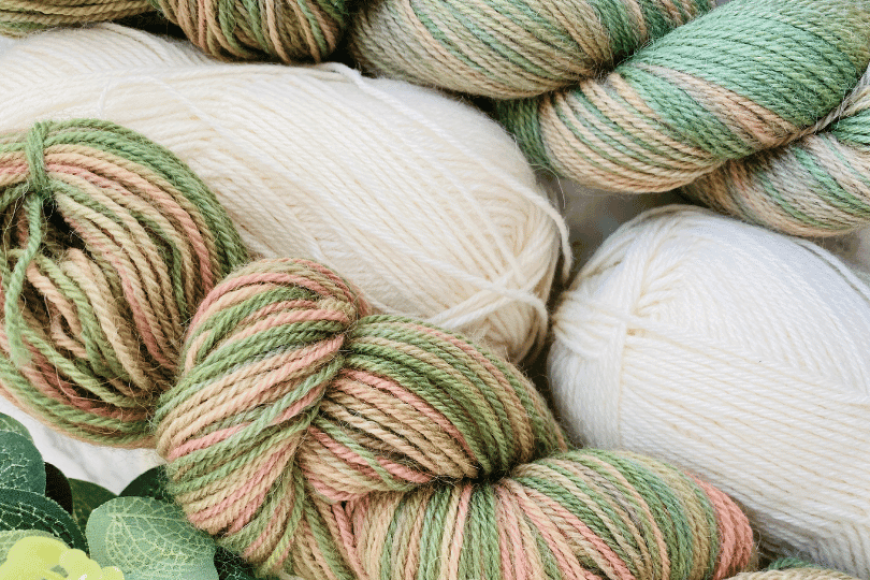How to Dye Yarn Yourself: A Beginner’s Guide with 5 Essential Tips
Dyeing yarn is a creative and deeply satisfying hobby. Today all about How to Dye Yarn Yourself: A Beginner’s Guide with 5 Essential Tips. Do you want to start dying your yarn? Keep reading for all the ins- and outs!
I first got into yarn dyeing two years ago after stumbling upon a wool dyeing video while watching a tutorial for a bag on YouTube. Curiosity got the better of me, and I decided to try it myself! I ordered a few skeins of sock yarn, purchased some food coloring online, and got to work. After plenty of trial and error, I was thrilled with the results. If you’re considering giving yarn dyeing a go, here are 5 essential tips to help you get started. Plus, we’ll answer some common questions about alternative dyeing techniques.
Tip 1: Not All Yarns Are Suitable for Dyeing
It may seem obvious, but beginners often forget that not all yarns can be dyed using every method. My first experiment was with sock yarn and food coloring, which works well for animal fibers like wool. However, if you want to dye acrylic or cotton yarn, you’ll need to use a textile dye such as Dylon. For wool and other animal fibers, you can use food coloring. Start by soaking the wool in water with a splash of vinegar to open up the fibers, and then apply heat to lock in the color. It’s worth noting that food coloring doesn’t work on plant-based fibers like cotton, which has been proven time and again by experienced dyers.
Tip 2: Start Small – Don’t Dye All Your Yarn at Once
While it may look exciting when professional dyers on social media work with large vats of yarn and vibrant colors, remember that these people have years of experience. If you’re just starting, don’t rush to buy expensive equipment. You don’t need a commercial-grade heat tray or professional dye pots right away. Instead, start with a single old pan on your stove and experiment with food coloring. Once you’ve mastered the basics and know that this hobby is for you, then you can invest in tools like a heat tray, which allows better control over temperature and color application.
Tip 3: Wear Gloves and Old Clothes
This might seem like a no-brainer, but in the excitement of creating something new, safety can be overlooked. Always wear old clothes when dyeing yarn because spills and splashes happen. You don’t want your favorite jeans to be permanently stained. Also, gloves are essential. Whether you’re using textile dye or food coloring, your hands will stain quickly. Food coloring may wash off more easily than textile dye, but it’s still best to protect your skin. I learned this the hard way when a tiny hole in my glove left me with a bright-colored thumb for a week! Also, protect your workspace—avoid working on carpets or cover the area with plastic or cardboard to prevent damage from accidental spills.
Tip 4: Properly Prepare Your Yarn
When you purchase yarn for dyeing, it often comes in skeins, which are loops of yarn held together by a contrasting thread. If you’re starting with regular balls of yarn, you’ll need to turn them into skeins before dyeing. A yarn swift is a handy tool for this, and you can find one easily on websites like AliExpress. Simply attach one end of the yarn to the swift and spin it until the ball transforms into a large loop, which is perfect for dyeing.
Tip 5: Be Critical About Your Color Choices
While experimenting with colors is fun, it’s important to be selective about your choices. You can dye yarn in rainbow hues, but ask yourself if you’ll really use or sell that yarn afterward. For inspiration, look at Instagram or YouTube to see how others mix and match colors. Sometimes, a single color in different shades can create a stunning result. If you plan on selling your yarn, make sure you have multiple skeins in the same color. Some people will want enough yarn for a sweater, while others may use it for smaller projects like scarves or doll clothes. And if you create something fantastic, be sure to write down your process, including how much dye you used, so you can replicate it later.
How About Acid Dyeing for Yarn?
If you’re looking to try a more professional method, acid dyeing is a popular choice for wool and other protein-based fibers (like alpaca and silk). Don’t be put off by the name; it’s not as harsh as it sounds! Acid dyes require only a mild acid like vinegar or citric acid, which helps the dye bond with the yarn fibers. Acid dyeing produces vibrant, long-lasting colors and is more permanent compared to food coloring. It’s widely used by experienced dyers for high-quality yarn dyeing. You’ll need specialized acid dyes (often available online) and a heat source to set the dye, but the process is relatively simple once you get the hang of it.
Can You Dye Yarn with Real Food or Flowers?
Yes, you can! Natural dyeing is another exciting option for yarn enthusiasts. You can use items like onion skins, avocado pits, and flowers to create beautiful, earthy shades. For example, avocado pits can produce soft pinks, while onion skins yield golden yellow tones. Keep in mind that natural dyes usually work best on animal fibers like wool, and the colors may be less vibrant compared to commercial dyes. You’ll also need a mordant, such as alum or vinegar, to help the color adhere to the yarn. The results are often more subtle but can be truly stunning, giving your yarn a unique, organic look.
When dyeing with flowers, it’s important to research which plants are safe and effective for this purpose. Marigolds, chamomile, and madder roots are just a few examples of plants that can yield beautiful colors when prepared properly.

